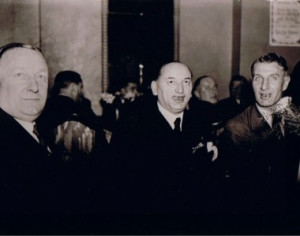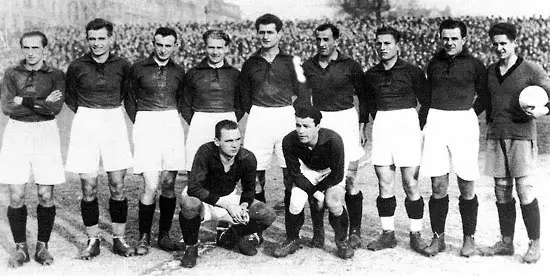MATCHES in the Mitropa Cup may not merit the same historical ranking as the Western Front truce games at Christmas, 1914, but they do provide another remarkable example of football’s capacity to narrow divides and bring people together.
When the competition was established in 1927, clubs were drawn from countries that had recently been part of Austria-Hungary. Relations could be cool at best. In little more than ten years, some would be at war and occupying others.
It’s especially surprising that Yugoslavia agreed to take part. The pre-war kingdom had a deep suspicion of both Austria and Hungary and their former Habsburg rulers. It was not inclined to co-operate with them.
Yet for all the bitterness, mistrust, and bearing of age-old grudges among its states, central Europe was a footballing powerhouse — a fact often overlooked in Britain where it’s often assumed England was the world’s top soccer county until the 1950s.
In fact, while the four home associations rested on their laurels, and maintained a fractious relationship with Fifa before resigning from the federation in 1928 to enter a 26-year period of splendid isolation, nations like Austria, Italy, and Hungary were embracing a modern game, perfecting their skills and adopting new tactics.
Professional leagues were being established too. The roots of central European dominance were already becoming apparent. It was the start of a shift in the balance of power
England did indeed beat newly-crowned world champions Italy 3-2 in 1934, in what became known as the Battle of Highbury. Yet it was a very close-run thing against a side reduced to ten men for 75 minutes. After Italy reorganised in the second half, home attacks made little impact while the visitors almost leveled after being 3-0 down.
Far from leading the world, England was actually being left behind. But that would only become apparent after the war and double humiliation at the hands of Hungary.
Ironically, the central European revolution was largely down to an Englishman named Jimmy Hogan who hailed from Nelson in Lancashire. Although the same British establishment that opposed floodlights and shirt numbers was too hidebound to take notice of him, continental clubs were very receptive to his radical coaching methods which stressed fitness, ball control, and the so-called combination game based on quick interplay and passing.
Hogan started managing in the Netherlands in 1910 and gradually made his way across Europe to Austria and Hungary. He worked with his friend Hugo Meisl to lead the Austrians to the Olympic final in 1936. And if he helped to put the wonder in the famous Austrian wunderteam, it’s fair to say he also made the Magyars magical. Hogan was the architect of their early post-war dominance and the Hungarians were only too happy to acknowledge the fact.
In 1953, after they won 6-3 at Wembley to become the first country from outside Britain and Ireland to beat England on home soil, manager Gusztav Sebes commented: “We played football as Jimmy Hogan taught us. When our football history is told, his name should be written in gold letters.” The praise of Hungarian Football Federation president Sandor Barcs was just as fulsome: “Jimmy Hogan taught us everything we know about football.”

Hungary’s performance had been mesmerising. England, steeped in the WM formation, were totally unable to comprehend their tactics. Centre-half Harry Johnston didn’t know what to do against a centre-forward, Nandor Hidegkuti, who stayed deep rather than leading the attack. All too often he found himself in no-man’s land.
The Mitropa Cup was launched to reinforce and cultivate this progress. Over the next few years, Mitropa countries dominated the game outside South America. Italy won the 1934 and 1938 World Cups, beating Czechoslovakia and Hungary respectively. In the 1936 Olympic final they defeated Austria.
An international club competition, 30 years before the European Cup, was a perfect example of forward-thinking and a willingness to accept new ideas. Even as late as the mid-1950s, when the weaknesses in the British game were all too apparent, Football League secretary Alan Hardaker was telling English clubs to stay out of European competitions. It took a man of the vision and stature of Manchester United manager Matt Busby to defy him.
The Mitropa Cup was the brainchild of Hugo Meisl. This in itself is worthy of note as in general the great competitions were established by Frenchmen. The original World Cup was the Jules Rimet Trophy. The winners of the European Championship receive the Henri Delaunay Trophy. The pre-Champions League European Cup was the idea of Gabriel Hanot and Jaques Ferran.
Football ran in the Meisl family’s veins. Hugo’s brother Willy was a sports journalist whose work did much to transform the way the sport was perceived and played on the Continent. He coined the term “the whirl” to describe the style of Hugo’s Austrian wunderteam.
The Mitropa Cup was launched at a meeting in Venice on July 17, 1926. It was open to champions and runners-up or cup-winners, and the first matches were played a month later. It was a two-legged knockout format and the founding entrants were Admira Vienna and Rapid Vienna (Austria), Slavia Prague and Sparta Prague (Czechoslovakia), MTK Budapest and Ujpest Dosza (Hungary) and BSK Belgrade and Hajduk Split (Yugoslavia). Sparta beat Rapid 7-4 on aggregate in the final.

Over the following years, before the outbreak of the Second World War, honours were fairly evenly shared. Austrian and Hungary claimed four wins each, the Czechs had three, and Italy two.
Yugoslavia quit the competition in 1929, being replaced by Italy, then returned in 1936 alongside new entrants from Latvia (Skonto), the Soviet Union (Tavriya Simferopol) and even Maccabi Tel Aviv from what was then the British Mandate of Palestine. Swiss side Young Fellows Zurich participated in 1937, and there were Romanian clubs in 1938. But by this point, the map of Europe was changing. Austria was absorbed into the German Reich and then Czechoslovakia was occupied and dismembered.
The final “pre-war” Mitropa Cup in the summer of 1940 was contested by clubs from Hungary, Romania, and Yugoslavia. Rapid Bucharest and Ferencvaros reached the final but it was never played.
It’s interesting to look at some of the clubs which competed between 1927 and 1940. Several that found themselves on the wrong side of the Iron Curtain in 1945 were forced to assume new names by the communist regimes. They re-emerged in the 1990s but in most cases are no longer the powers they once were.
Belgrade Sports Club (BSK) was one of the top sides in pre-war Yugoslavia, winning five championships. In 1945 it was re-formed as Metalac and since 1957 has been OFK Belgrade who now play in the Serbian third division. Gradjanski Zagreb, who also won five pre-war Yugoslav titles, were replaced by Dinamo Zagreb.
MTK Budapest were taken over by the Hungarian secret police in 1949 and for many years were known as Voros Logobo, which translates as a red flag. Rapid Bucharest, one of Romania’s top inter-war clubs, was forced to take on the Soviet-style title Lokomotiv. After many ups and downs, they are now a second division outfit.
The Mitropa Cup was revived in 1951 and continued under different names and with some gaps until 1992. But by that point, it was very much reduced in status and in the shadow of what were three main European competitions when the cup winners’ cup was being played.
Yet without the pre-war competition, who knows how European club football and indeed the sport as a whole might have developed? The Mitropa Cup showed it was possible for a competition to transcend national boundaries and bring countries together — even ones that were enemies.
Pre-war Winners
1927: Sparta Prague
1928: Ferencvaros
1929: Ujpest
1930: Rapid Vienna
1931: First Vienna
1932: Bologna
1933: Austria Vienna
1934: Bologna
1935: Sparta Prague
1936: Austria Vienna
1937: Ferencvaros
1938: Slavia Prague
1939: Ujpest








